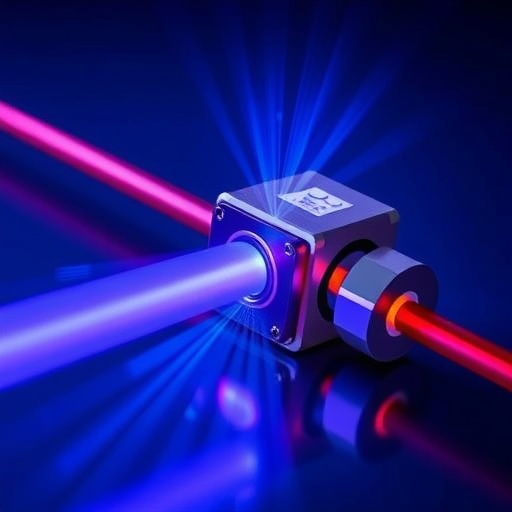In a groundbreaking development at the intersection of nanotechnology and optoelectronics, researchers have unveiled an advanced metaphotonic photodetector that uniquely addresses the challenges of direct Stokes quantification. This innovation emerges as a pivotal solution in multidimensional optoelectronic applications, particularly in scenarios that demand acute precision and reliability, such as Stokes detection. Conventional methodologies for Stokes detection heavily rely on complex and often cumbersome post-signal processing algorithms to reconstruct physical quantities from multiparameter optical responses. However, the advancement brought forth by the integration of channel-level decoupling into the device design significantly shifts this paradigm.
The innovation lies in the design of the device, which employs nanoengineered materials to manipulate electromagnetic fields. By establishing independent photovoltage channels for each Stokes parameter, the researchers have effectively minimized crosstalk—an issue that often complicates the decoding of signals in multifaceted optical systems. This method not only improves the accuracy of the measurements but also streamlines the overall detection process, making it more efficient and accessible. The device achieves a remarkable condition number, nearing unity, which is a critical metric in assessing how effectively the device can operate without the interference of external signal fluctuations and noise.
In essence, this metaphotonic system eliminates much of the unpredictability associated with traditional Stokes parameter detection methods. The researchers recognize that conventional detection techniques can falter when faced with coupled response channels and variable signal amplitudes. In these contexts, valuable information can be lost, leading to inaccuracies and inefficiencies. By integrating an approach that emphasizes device-level optimization alongside algorithmic strengths, this new photodetector stands out as a formidable advancement in the field.
One of the most significant benefits of this metaphotonic device is its ability to perform Stokes quantification directly, without necessitating complex algorithmic post-processing. Unlike previous models that were heavily reliant on computational methods to extract information from optical responses, this photodetector is crafted to provide immediate, clear measurements. This capability allows for real-time applications that were previously hindered by the lag associated with data processing—giving researchers and developers a decisive edge in various optoelectronic applications.
Furthermore, the implications of this technology extend beyond mere efficiency improvements; they also encompass enhanced performance in fields where precise control and analysis of light are critical. The areas of telecommunications, imaging technologies, and sensor applications can all benefit from the ability to detect Stokes parameters with unprecedented accuracy and speed. As researchers continue to explore the boundaries of what metaphotonics can achieve, potential applications may span from quantum computing to advanced imaging techniques applicable in both medical and industrial settings.
The researchers underscore the pivotal role of machine learning algorithms in the development of metaphotonic devices. While the new detector minimizes dependence on these complex computational techniques, it does not entirely eliminate them from the conversation. Instead, they can still serve as supplementary tools in refining the performance of the detection system. The combination of these advanced algorithms with the low-crosstalk, high-responsivity device creates a synergistic effect, elevating the capabilities and performance of photodetectors in contemporary science.
The potential for real-world applications of this innovation is substantial. Researchers envision breakthroughs in healthcare diagnostics, where immediate and precise quantification of optical signals could lead to earlier detection of conditions and more tailored treatments. Additionally, industries that rely on optical sensing and measurement may see transformative changes, including more efficient manufacturing processes and heightened accuracy in quality control standards through improved detection mechanisms.
The results of this research mark a significant milestone in the evolution of metaphotonics. By effectively addressing the longstanding challenges of signal decoding in Stokes detection, the researchers pave the way for future innovations that leverage the principles of light manipulation. This lays a foundation beyond just theoretical experiments; it opens doors for practical applications that could redefine standards across multiple scientific and engineering fields.
In conclusion, the metaphotonic photodetector stands at the forefront of a new wave of technology capable of transforming our understanding and manipulation of light. This device not only improves the current methodologies in Stokes quantification but also sets a precedent for future research endeavors. As the potential for high-accuracy, low-inference photodetection becomes a reality, we can only speculate about the spectacular advancements that lie ahead in the realms of nanotechnology and optoelectronics.
Thus, with the unveiling of this cutting-edge metaphotonic photodetector, the bridge between theoretical possibilities and practical applications in optoelectronics continues to close, heralding a new era of efficiency and precision in optical measurements.
Subject of Research: Metaphotonics and Stokes Detection
Article Title: Metaphotonic Photodetectors for Direct Stokes Quantification
Article References:
Liu, X., Chen, Y., Kong, X. et al. Metaphotonic photodetectors for direct Stokes quantification.
Nat Electron (2025). https://doi.org/10.1038/s41928-025-01481-4
Image Credits: AI Generated
DOI: 10.1038/s41928-025-01481-4
Keywords: metaphotonics, Stokes quantification, photodetector, nanotechnology, optoelectronics, signal processing, machine learning, low-crosstalk detection.
Tags: channel-level decoupling techniquesefficiency in optical measurementselectromagnetic field manipulationindependent photovoltage channelsmetaphotonic photodetectorsminimizing signal noise in photodetectionmultidimensional optoelectronic applicationsnanotechnology in optoelectronicsoptical signal processing innovationsprecision Stokes detection methodsreducing crosstalk in detectorsStokes quantification advancements





